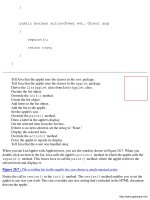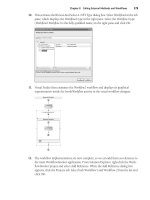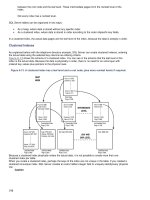Linux Socket Programming by Example PHẦN 6 pot
Bạn đang xem bản rút gọn của tài liệu. Xem và tải ngay bản đầy đủ của tài liệu tại đây (851.42 KB, 51 trang )
413: rpn_process(FILE *tx,char *buf) {
414: int z;
415: mpz_t *t;
416: char *operation;
417: char *operand;
418:
419: operation=strtok(buf,":\n\r");
420: operand=strtok(NULL,"\n\r");
421:
422: if ( !strcmp(operation,"dump") ) {
423: rpn_dump(tx);
424:
425: } else if ( !strcmp(operation,"=") ) {
426: /*
427: * Pop off the result:
428: */
429: if ( (z = rpn_pop(&t)) == -1 )
430: fputs("E:Nothing to pop\n",tx);
431: else {
432: fprintf(tx,"%d:",z);
433: mpz_out_str(tx,10,*t);
434: fputc('\n',tx);
435: rpn_free(&t);
436: }
437:
438: } else if ( !strcmp(operation,"#") ) {
439: /*
440: * Push an operand onto the stack:
441: */
442: t = rpn_alloc();
443: if ( !mpz_set_str(*t,operand,10) )
444: fprintf(tx,"%d:\n",rpn_push(t));
445: else {
446: fputs("E:Invalid number\n",tx);
447: rpn_free(&t);
448: }
449:
450: } else {
451: /*
452: * Perform an operation:
453: */
454: z = rpn_opr(operation);
455: if ( z == -1 )
456: fprintf(tx,
457: "E:Operation failed.\n");
458: else
459: fprintf(tx,"%d:\n",z);
460: }
461:
462: fflush(tx);
463: }
Linux Socket Programming by Example - Warren W. Gay
257
While Listing 10.5 is quite long, only the server concepts within
it are important to you here. Consequently, only the rpn_process()
function will be described:
1. The rpn_process() function is called with the output stream
to write to (argument tx), and the input text line in buf to
process (line 413).
2. The variables operation and operand are the parsed operation
and operand strings, respectively (lines 419 to 420).
3. If the operation is special operation "dump", the function
rpn_dump() is called to list the contents of the stack (lines
422 to 423).
4. If step 3 does not apply, and if the operation is "=", the
value is popped off the stack and returned to the client
program (lines 425 to 436). Proceed to step 7.
5. If steps 3 and 4 do not apply, and if the operation is "#",
the operand value is pushed onto the stack (lines 438 to
448). Proceed to step 7.
6. If steps 3, 4, and 5 do not apply, all other RPN operations
are handled by the function rpn_opr(). The result reported
back to the client is the stack index value or an error
indication (lines 454 to 460).
7. The output is forced to be written to the socket by calling
fflush(tx) in line 462.
How the server works from the client side, will be examined
after the remainder of the server code is presented. Listing 10.6
shows the remainder of the server source code. This represents
the main program segment of the server.
Listing 10.6 rpnsrv.c—The RPN Main Server Code
1: /* rpnsrv.c:
2: *
3: * Example RPN Server:
4: */
5: #include <stdio.h>
6: #include <unistd.h>
7: #include <stdlib.h>
8: #include <errno.h>
9: #include <string.h>
10: #include <time.h>
11: #include <sys/types.h>
12: #include <sys/socket.h>
13: #include <netinet/in.h>
14: #include <arpa/inet.h>
15: #include <netdb.h>
16:
Linux Socket Programming by Example - Warren W. Gay
258
17: #ifndef SHUT_RDWR
18: #define SHUT_RDWR 3
19: #endif
20:
21: extern int mkaddr(void *addr,
22: int *addr_len,
23: char *input_address,
24: char *protocol);
25:
26: extern void rpn_process(FILE *tx,
27: char *buf);
28:
29:
30: /*
31: * This function reports the error and
32: * exits back to the shell:
33: */
34: static void
35: bail(const char *on_what) {
36: if ( errno != 0 ) {
37: fputs(strerror(errno),stderr);
38: fputs(": ",stderr);
39: }
40: fputs(on_what,stderr);
41: fputc('\n',stderr);
42: exit(1);
43: }
44:
45: int
46: main(int argc,char **argv) {
47: int z;
48: char *srvr_addr = "127.0.0.1:9090";
49: struct sockaddr_in adr_srvr;/* AF_INET */
50: struct sockaddr_in adr_clnt;/* AF_INET */
51: int len_inet; /* length */
52: int s = -1; /* Socket */
53: int c = -1; /* Client socket */
54: FILE *rx = NULL; /* Read stream */
55: FILE *tx = NULL; /* Write stream */
56: char buf[4096]; /* I/O Buffer */
57:
58: /*
59: * Use a server address from the command
60: * line, otherwise default to 127.0.0.1:
61: */
62: if ( argc >= 2 )
63: srvr_addr = argv[1];
64:
65: len_inet = sizeof adr_srvr;
66: z = mkaddr(&adr_srvr,&len_inet,
67: srvr_addr,"tcp");
68:
Linux Socket Programming by Example - Warren W. Gay
259
69: if ( z < 0 || !adr_srvr.sin_port ) {
70: fprintf(stderr,"Invalid server "
71: "address, or no port number "
72: "was specified.\n");
73: exit(1);
74: }
75:
76: /*
77: * Create a TCP/IP socket to use:
78: */
79: s = socket(PF_INET,SOCK_STREAM,0);
80: if ( s == -1 )
81: bail("socket(2)");
82:
83: /*
84: * Bind the server address:
85: */
86: z = bind(s,(struct sockaddr *)&adr_srvr,
87: len_inet);
88: if ( z == -1 )
89: bail("bind(2)");
90:
91: /*
92: * Make it a listening socket:
93: */
94: z = listen(s,10);
95: if ( z == -1 )
96: bail("listen(2)");
97:
98: /*
99: * Start the server loop:
100: */
101: for (;;) {
102: /*
103: * Wait for a connect:
104: */
105: len_inet = sizeof adr_clnt;
106: c = accept(s,
107: (struct sockaddr *)&adr_clnt,
108: &len_inet);
109: if ( c == -1 )
110: bail("accept(2)");
111:
112: /*
113: * Create streams:
114: */
115: rx = fdopen(c,"r");
116: if ( !rx ) {
117: /* Failed */
118: close(c);
119: continue;
120: }
121:
122: tx = fdopen(dup(c),"w");
123: if ( !tx ) {
Linux Socket Programming by Example - Warren W. Gay
260
124: fclose(rx);
125: continue;
126: }
127:
128: /*
129: * Set both streams to line
130: * buffered mode:
131: */
132: setlinebuf(rx);
133: setlinebuf(tx);
134:
135: /*
136: * Process client's requests:
137: */
138: while ( fgets(buf,sizeof buf,rx) )
139: rpn_process(tx,buf);
140:
141: /*
142: * Close this client's connection:
143: */
144: fclose(tx);
145: shutdown(fileno(rx),SHUT_RDWR);
146: fclose(rx);
147: }
148:
151: }
The main features of the server code in Listing 10.6 should be
relatively familiar to you now. The basic steps used in this
module were as follows:
1. The C macro SHUT_RDWR is defined in line 18, if the macro is
not already defined. This makes the source code clearer
when shutdown(2) is being called later in the program.
2. The server's address is taken from the command line, if it
is present (lines 62 and 63).
3. The mkaddr() subroutine is called to construct a server
address for us in lines 65 to 74.
4. A server socket is created (lines 79 to 81).
5. The server address is bound to the socket (lines 86 to 89).
6. The socket is made into a listening socket (lines 94 to 96).
7. The program waits for a client to connect (lines 105 to
110).
8. Input and output file streams are created in lines 115 to
126. Notice that error recovery must ensure that the
currently open streams and client socket are closed. The
error itself is not reported by this server, if it should occur.
Linux Socket Programming by Example - Warren W. Gay
261
9. The I/O streams are set to line buffered mode (lines 132 to
133).
10. Until EOF is reached, each text line is read from the client
and processed by the function rpn_process() (lines 138 to
139).
11.A full shutdown is performed for this client (lines 144 to
146).
12.Repeat step 7 to accommodate the next client connection.
Although limited, you can see that Listing 10.6 is a simple
server loop that keeps accepting client connections in single-file
fashion. Later, you'll learn how to write a higher-performance
server that can concurrently process several clients at one time.
Trying Out the RPN Server
To compile all the related source modules for the RPN server,
you can perform the following make command:
$ make rpnsrv
gcc -c -D_GNU_SOURCE -Wall -Wreturn-type rpnsrv.c
gcc -c -D_GNU_SOURCE -Wall -Wreturn-type rpneng.c
gcc -c -D_GNU_SOURCE -Wall -Wreturn-type mkaddr.c
gcc rpnsrv.o rpneng.o mkaddr.o -o rpnsrv -lgmp
$
After the executable rpnsrv for the server has been created, you
can start the server as follows:
$ ./rpnsrv &
[1] 13321
$
In the output shown, the server was started with a process ID of
13321, and run in the background.
To keep things simple at this point, you'll just use the telnet
command to try out the server. The next chapter will fully
outline this server's functions. For now, just try some simple
tests.
Caution
The server presented is not a production-grade server. Some
forms of incorrect input can provoke the server to abort.
Linux Socket Programming by Example - Warren W. Gay
262
The RPN calculator computes based upon numbers that are
pushed onto the stack. To perform the add operation, for
example, requires at least two numbers to exist on the stack. To
push a number onto the stack, you will enter a line as follows:
#:970976453
After you press Enter, the server will respond with something
like this:
0:
This tells you that the number has been stacked at the bottom
of the stack (entry number zero). To stack another number,
simply do the same, as follows:
#:2636364
The server will respond with
1:
This indicates that the number 2636364 was stacked at position
1, although the original number 970976453 still sits at the bottom
of the stack at position 0. You can list the current contents of
the stack by entering the following:
dump
The following example shows what the session and its output
might look like this:
$ telnet localhost 9090
Trying 127.0.0.1
Connected to localhost.
Escape character is '^]'.
#:970976453
0:
#:2636364
1:
dump
1:2636364
0:970976453
E:end of stack dump
Linux Socket Programming by Example - Warren W. Gay
263
To perform a binary operation, you simply enter the name of the
operation or its symbol. For example, to add these numbers,
you would just enter the + character and press return. The
session repeated without entering the dump command would
appear as follows if the + operation was performed, and then
followed by the = operation:
$ telnet localhost 9090
Trying 127.0.0.1
Connected to localhost.
Escape character is '^]'.
#:970976453
0:
#:2636364
1:
+
0:
=
0:973612817
^]
telnet> c
Connection closed.
$
The + operation caused the two stacked numbers to be added
together, and the result replaced the two original values. The =
operator here pops the result off the stack and displays it for
you.
To exit the server, type CTRL+] and you will be prompted with
the prompt:
telnet>
From there, enter a c to indicate that you want the session
closed, and press Enter. To terminate the server, just use the kill
command.
Take a few minutes now to have some fun with the new RPN
calculating server program. Restart the server, and see whether
you can figure out how to compute the equation (3 + 2) * (2 + 4)
using the calculating server just presented.
After your experiment, you deserve a break. The server will be
more fully explored in the next chapter as you look at more
advanced server issues. For now, just take stock of the concepts
you have mastered in this chapter.
Linux Socket Programming by Example - Warren W. Gay
264
What's Next
This chapter has introduced you to the idea of using FILE
streams with your sockets. You can readily appreciate how
streams will make certain tasks much simpler for your code,
such as the input and output of text lines.
You also learned to be aware of the EINTR problem if the glibc
library should change or if your code is ported to another UNIX
platform.
The next chapter will teach you how servers can service multiple
client connections at the same time. This is not as trivial as you
might imagine.
Chapter 11. Concurrent Client
Servers
All of the servers presented in this text so far have processed
one client's request in total before accepting a connection to
the next client. This design is effective and simple for servers
that reply swiftly. However, if the processing takes a long time,
or there are periods of inactivity, then this will prevent other
clients from being serviced without lengthy delays. Because
servers are usually required to service as many clients as
possible, with a minimum of delay, a fundamental design
change is needed at the server end of the connection.
In this chapter you will learn how to use the following:
• The fork(2) function in order to handle multiple client
connections
• The wait(2) and waitpid(2) functions
• The select(2) function for handling multiple client
connections
Mastering these concepts will permit you to write professional-
grade servers, which can service large numbers of clients at
once.
Linux Socket Programming by Example - Warren W. Gay
265
Understanding the Multiple-Client
Problem
Figure 11.1 shows several clients, which have contacted one
server. The client connections conceptually form spokes around
the central server.
Figure 11.1. Several clients attached to one server can be
graphically represented as spokes attached to a hub.
The server, acting as the central hub in Figure 11.1, must
balance its resources among several connected clients. The
server is normally designed to behave such that each client
thinks that it has dedicated server access. In reality, however,
the server services all clients in a concurrent manner.
There are a few of ways of achieving this. They are
• Forked server processes (multi-process method)
• Threaded server processes (multi-thread method)
• One process and a select(2) call
• One process and a poll(2) call
The first method of using the fork(2) system call is perhaps the
simplest way to service multiple-client processes. However, it
suffers from the dis-advantage that sharing information
becomes more complex. This usually requires the use of
Linux Socket Programming by Example - Warren W. Gay
266
message queues, shared memory, and semaphores. It also
suffers from the disadvantage that it requires more CPU to start
and manage a new process for each request.
The threaded server method is relatively new to UNIX, and is
now a viable option for Linux. Kernel versions 2.0.0 and later
support threads, provided that the appropriate thread-safe
libraries are used. Threads offer the lightweight advantages of
the multi-process method, without hampering centralized
communication. Threaded processes can be very difficult to
debug, however, especially for beginning programmers. For this
reason, threads will not be explored in this text.
Tip
Frequently Asked Question (FAQ) documents that describe
threads in more detail under Linux are available on the Internet
for your viewing. Some references to these are
The last two methods listed involve the use of the select(2) or
poll(2) function calls. Each of these functions offer a different
way to block execution of the server until an event occurs. The
select(2) function will be examined in detail within this chapter.
The interested reader is encouraged to read the man pages for
poll(2) after completing this chapter.
Overview of Server Functions
Chapter 10, "Using Standard I/0 on Sockets," introduced the
Reverse Polish Notation (RPN) calculating server. Only its most
primitive functions were described, however. Before you dive
into the server's design aspects in this chapter, you should get
to know some of the server's capabilities first. In this manner,
you'll be able to give the server a better workout.
Linux Socket Programming by Example - Warren W. Gay
267
The most basic functions are listed in Table 11.1. These describe
the most rudimentary arithmetic and operating functions
available.
Table 11.1. The Rudimentary RPN Server Functions
Function Argument Description
# Integer An integer value to push onto the stack.
+ N/A Add the two numbers on the top of the
stack. The numeric resulting number
replaces these two values on the top of the
stack.
- N/A Subtract the top number from the next to
last number on the stack. The result
replaces the two values on the top of the
stack.
* N/A Multiply the two numbers on the top of the
stack. The resulting value replaces the two
numbers on the top of the stack.
/ N/A Divide the top number into the next to last
number on the top of the stack. The
integer result replaces these two numbers
on the top of the stack.
% N/A Replace the top two numbers on the stack
with the modulo result (remainder) of the
top number divided into the next to last
number.
= N/A The top result is popped off of the stack
and returned to the client.
dump N/A The entire stack is dumped back to the
client. The stack is left unmodified.
Listing 11.1 shows a simple calculation being performed. Then
the functions dump and = are tested prior to exiting the server.
Listing 11.1 Testing the Basic RPN Server Functions
$ telnet localhost 9090
Trying 127.0.0.1…
Connected to localhost.
Escape character is '^]'.
#:3
Linux Socket Programming by Example - Warren W. Gay
268
0:
#:4
1:
#:7
2:
dump
2:7
1:4
0:3
E:end of stack dump
+
1:
dump
1:11
0:3
E:end of stack dump
*
0:
dump
0:33
E:end of stack dump
=
0:33
dump
E:end of stack dump
^]
telnet> c
Connection closed.
$
The session showed how to compute the following:
3 * (4 + 7)
The steps performed in Listing 11.1 are as follows:
1. The three values 3, 4, and 7 are first pushed onto the stack.
2. The stack is dumped with the dump operation.
3. The + operation is performed, which causes 4 + 7 to be
evaluated and its result 11 to be placed on the stack in
place of the inputs.
4. The stack is dumped again using dump. From this, you can
see that the values 3 and 11 remain on the stack.
5. The multiplication of 3 * 11 is evaluated when * is entered.
The result of 33 replaces the input values on the stack.
6. The dump operation is performed again to show the stack
contents. It shows the single result of 33 on the stack.
7. The = operation pops this last value off the stack.
8. The dump operation now shows an empty stack.
Linux Socket Programming by Example - Warren W. Gay
269
9. The telnet session is closed using CTRL+] and then the c
character followed by a RETURN.
Unary functions supported by the server are shown in Table
11.2.
Table 11.2. Unary RPN Server Functions
Function Argument Description
abs N/A The top stack value is replaced with the
absolute value of that number.
neg N/A The top stack value is replaced with the
negated value of that number.
sqrt N/A The top stack value is replaced with the
integer square root of that number.
Note that the unary functions only require one number to exist
on the stack. Table 11.3 lists some more advanced functions
that the RPN server supports.
Table 11.3. Advanced RPN Server Functions
Function Argument Description
gcd N/A Compute the greatest common divisor
between the top two numbers on the
stack. The result replaces the top two
numbers on the stack.
seed N/A Use the value on the top of the stack as a
random number seed value. There is no
result pushed onto the stack.
random N/A Use the value on the top of the stack to act
as the largest value + 1 for the random
number to be generated. The random
result replaces the input value on the
stack.
tprime N/A Test the top stack value to see if it is a
prime number. The second-to-last number
on the top of the stack indicates how many
tests to apply. A typical value is 25. The
result replaces the two input values on the
Linux Socket Programming by Example - Warren W. Gay
270
Table 11.3. Advanced RPN Server Functions
Function Argument Description
stack. A result of 1 indicates that the
number is probably prime, while 0
indicates that the number is not prime.
genprime N/A Generate a prime number, using the top of
the stack as a "maximum random number
+ 1" value (see random). The second-to-last
number on the stack indicates the number
of tests to perform (typically 25). The
generated result replaces the top two
values.
swap N/A Swap the top two values on the stack.
Useful for exchanging two numbers.
dup N/A Duplicate the top value on the stack.
The use of the seed and random functions require a bit of
explanation. The seed function allows you to predictably seed a
random number generator. This is important if you want to
reproduce a set of random numbers for subsequent tests. For
example:
#:1000
0:
seed
0:
#:3000
0:
random
0:
dump
0:560
This sequence seeds the random number generator with the
value 1000. Later, 3000 is input to the function random which
produces the random result 560. The value 3000 acts as a
maximum value + 1 for the random function. With this as an
input value, the random number generated could be between
the values of 0 and 2999.
The genprime function works similarly. Take for example:
#:25
0:
Linux Socket Programming by Example - Warren W. Gay
271
#:9999999999999999999999999999999
1:
genprime
0:
dump
0:7316946669968331260251308920347
E:end of stack dump
This example shows how a large prime number is generated.
The value 25 pushed, causing the generated number to be
tested 25 times to see if it is a prime number. If you need better
assurance that the number is prime, you must use a larger test
value. The function tprime works the same way, except that it
produces a test result of zero or one instead. One indicates the
number was tested as probably prime.
Note
The prime number tests are implemented in the GMP library
function mpz_probab_prime_p(). This function implements a
"probabilistic primality test" based upon the work by Donald E.
Knuth, The Art of Computer Programming, vol 2, Seminumerical
Algorithms, 2nd edition, Addison-Wesley, 1981.
The result of the function indicates a high probability that the
number is prime. The probability of returning a false positive
indication is (1/4)<+>
r
, where r represents the number of tests
to be performed. The documentation states that the value of 25
is a reasonable number for r.
Using fork(2) to Service Multiple Clients
The server that was developed in Chapter 10 has been modified
in this section to handle multiple clients by means of a fork(2)
system call. Listing 11.2 shows the listing of the modified
rpnsrv.c module. All other source modules remain the same as
they appeared in the previous chapter.
Listing 11.2 rpnsrv.c—The fork(2) Modified RPN Server
1: /* rpnsrv.c:
2: *
3: * Example RPN Server:
4: */
5: #include <stdio.h>
6: #include <unistd.h>
7: #include <stdlib.h>
8: #include <errno.h>
9: #include <string.h>
Linux Socket Programming by Example - Warren W. Gay
272
10: #include <time.h>
11: #include <sys/types.h>
12: #include <sys/socket.h>
13: #include <netinet/in.h>
14: #include <arpa/inet.h>
15: #include <netdb.h>
16: #include <sys/wait.h>
17: #include <signal.h>
18:
19: #ifndef SHUT_RDWR
20: #define SHUT_RDWR 3
21: #endif
22:
23: extern int mkaddr(void *addr,
24: int *addr_len,
25: char *input_address,
26: char *protocol);
27:
28: extern void rpn_process(FILE *tx,
29: char *buf);
30:
31: /*
32: * Process Terminated Child processes:
33: */
34: static void
35: sigchld_handler(int signo) {
36 pid_t PID;
37: int status;
38:
39: do {
40: PID = waitpid(-1,&status,WNOHANG);
41: } while ( PID != -1 );
42:
43: /* Re-instate handler */
44: signal(SIGCHLD,sigchld_handler);
45: }
46:
47: /*
48: * This function reports the error and
49: * exits back to the shell:50: */
51: static void
52: bail(const char *on_what) {
53: if ( errno != 0 ) {
54: fputs(strerror(errno),stderr);
55: fputs(": ",stderr);
56: }
57: fputs(on_what,stderr);
58: fputc('\n',stderr);
59: exit(1);
60: }
61:
62: int
63: main(int argc,char **argv) {
64: int z;
65: char *srvr_addr = "127.0.0.1:9090";
Linux Socket Programming by Example - Warren W. Gay
273
66: struct sockaddr_in adr_srvr;/* AF_INET */
67: struct sockaddr_in adr_clnt;/* AF_INET */
68: int len_inet; /* length */
69: int s = -1; /* Socket */
70: int c = -1; /* Client socket */
71: FILE *rx = NULL; /* Read stream */
72: FILE *tx = NULL; /* Write stream */
73: char buf[4096]; /* I/O Buffer */
74: pid_t PID; /* Process ID */
75:
76: /*
77: * Set signal handler for SIGCHLD:
78: */
79: signal(SIGCHLD,sigchld_handler);
80:
81: /*
82: * Use a server address from the command
83: * line, otherwise default to 127.0.0.1:
84: */
85: if ( argc >= 2 )
86: srvr_addr = argv[1];
87:
88: len_inet = sizeof adr_srvr;
89: z = mkaddr(&adr_srvr,&len_inet,
90: srvr_addr,"tcp");
91:
92: if ( z < 0 || !adr_srvr.sin_port ) {
93: fprintf(stderr,"Invalid server "
94: "address, or no port number "
95: "was specified.\n");
96: exit(1);
97: }
98:
99: /*
100: * Create a TCP/IP socket to use:
101: */
102: s = socket(PF_INET,SOCK_STREAM,0);
103: if ( s == -1 )
104: bail("socket(2)");
105:
106: /*
107: * Bind the server address:
108: */
109: z = bind(s,(struct sockaddr *)&adr_srvr,
110: len_inet);
111: if ( z == -1 )
112: bail("bind(2)");
113:
114: /*
115: * Make it a listening socket:
116: */
117: z = listen(s,10);
Linux Socket Programming by Example - Warren W. Gay
274
118: if ( z == -1 )
119: bail("listen(2)");
120:
121: /*
122: * Start the server loop:
123: */
124: for (;;) {
125: /*
126: * Wait for a connect:
127: */
128: len_inet = sizeof adr_clnt;
129: c = accept(s,
130: (struct sockaddr *)&adr_clnt,
131: &len_inet);
132: if ( c == -1 )
133: bail("accept(2)");
134:
135: /*
136: * Fork a new server process
137: * to service this client: >
138: */
139: if ( (PID = fork()) == -1 ) {
140: /* Failed to fork: Give up */
141: close(c);
142: continue;
143: } else if ( PID > 0 ) {
144: /* Parent process: */
145: close(c);
146: continue;
147: }
148:
149: /*
150: * CHILD PROCESS:
151: * Create streams:
152: */
153: rx = fdopen(c,"r");
154: if ( !rx ) {
155: /* Failed */
156: close(c);
157: continue;
158: }
159:
160: tx = fdopen(dup(c),"w");
161: if ( !tx ) {
162: fclose(rx);
163: continue;
164: }
165:
166: /*
167: * Set both streams to line
168: * buffered mode:
169: */
Linux Socket Programming by Example - Warren W. Gay
275
170: setlinebuf(rx);
171: setlinebuf(tx);
172:
173: /*
174: * Process client's requests:
175: */
176 while ( fgets(buf,sizeof buf,rx) )
1: rpn_process(tx,buf);
178:
179: /*
180: * Close this client's connection:
181: */
182: fclose(tx);
183: shutdown(fileno(rx),SHUT_RDWR);
184: fclose(rx);
185:
186: /*
187: * Child process must exit:
188: */
189: exit(0);
190: }
191:
192: /* Control never gets here */
193: return 0;
194: }
The following session shows how to compile and to start the
server in the background:
$ make rpnsrv
gcc -c -D_GNU_SOURCE -Wall -Wreturn-type rpnsrv.c
gcc -c -D_GNU_SOURCE -Wall -Wreturn-type rpneng.c
gcc -c -D_GNU_SOURCE -Wall -Wreturn-type mkaddr.c
gcc rpnsrv.o rpneng.o mkaddr.o -o rpnsrv -lgmp
$ ./rpnsrv '*:9090' &
[2] 915
$
After the server has been started, you can use telnet from
multiple xterm windows to try out the server simultaneously. If
you are not running the X Window system, you can use various
virtual console sessions to accomplish the same effect.
The principle changes to the module are as follows:
• The <sys/wait.h> and <signal.h> include files were added in
lines 16 and 17.
• A signal handler for SIGCHLD was added to lines 34 to 45.
• A process ID variable PID was declared in line 74.
• The SIGCHLD signal handler was installed at line 79.
• A call to fork(2) was added in lines 139 to 147.
Linux Socket Programming by Example - Warren W. Gay
276
• A call to exit(2) was added at line 189.
Understanding the Overall Server Process
The basic main program of the server now functions as follows:
1. A signal handler for SIGCHLD is installed at line 79. This will
play a role for terminated processes, which will be
discussed later.
2. A server address and socket are created (lines 85 to 112).
3. The socket is converted to a listening socket (lines 117 to
119).
4. The main loop begins (line 124).
5. The server blocks its execution until a client connects
(lines 128 to 133).
6. The fork(2) function is called in line 139.
7. If step 6 fails, the value -1 is returned by fork(2) and the
server closes the connected socket c (line 141). Then the
loop repeats with step 5.
8. If step 6 succeeds, then PID will contain the process ID of
the child process in the parent process (lines 144 to 147).
The parent process simply closes the accepted connection
c and repeats step 5.
The parent process loops between steps 5 to 8 until the server
is killed off. Effectively, the parent process only accepts
connections. It does no other work.
Understanding the Child Server Process Flow
The child process in Listing 11.2, created by the fork(2) process
in step 6, follows these steps:
1. Because the fork(2) function returns zero for the child
process, its code continues execution at line 153.
2. The child process keeps socket c open and associates this
socket with FILE streams tx and rx (lines 153 to 164).
3. Processing continues in the child process as normal in
lines 170 to 184.
4. At this stage, the child process has finished processing for
the client. The exit(3) function is called to terminate the
child process (line 189). This step will cause the signal
SIGCHLD to be raised in the parent server process.
Linux Socket Programming by Example - Warren W. Gay
277
Note that the parent process closes the socket c in line 145. This
is important because, after the fork(2) call, both parent and
client processes have this connected socket open. The parent
process is not servicing the client request, so it simply closes
the socket. The child process, however, will process the client's
requests and uses the open socket in variable c.
With this design, the connected client can take its merry time in
submitting requests without making other clients of the same
server wait. This is because the parent server process simply
accepts new connections. The parent server process performs
the following steps:
1. Accept a connection from a client.
2. Fork a new process to service the client.
3. Close its copy of the connected client's socket.
4. Repeat step 1.
The servicing of the connected client is simple, because the
server child process only has to worry about one connected
socket.
Understanding Process Termination Processing
The one complication that the fork(2) function call inflicts upon
the design of the server is that it must process information
about terminated processes. This is very important, because
when a child process terminates, most of its resources are
released. The rest of its resources are released only when the
parent process obtains the child process termination status
information.
The parent process is notified of a child process termination by
means of the signal SIGCHLD. Now examine the steps that the
parent server process uses when a child process terminates:
1. The signal SIGCHLD is raised by the kernel to indicate that
the child process has terminated.
2. The function sigchld_handler() is called (line 35), because the
function was registered for the SIGCHLD signal in line 79.
3. The sigchld_handler() executes a loop calling waitpid(2) until
no more exit status information is available.
4. The SIGCHLD handler is re-instated in line 44. This was
necessary because the reliable signals interface was not
used in order to keep the example program simple.
Linux Socket Programming by Example - Warren W. Gay
278
Note
In a production mode server, only the reliable signal functions
such as sigaction(2) should be used. This was avoided in the
example program to keep the source code simple.
Caution
Failure to call wait(2) or waitpid(2) by the parent process after a
fork(2) and the child process's subsequent termination will result
in zombie processes being left around until the parent process
terminates. This can tie up valuable system resources.
The reader is encouraged to review the functions fork(2),
waitpid(2), and signal(2), if necessary. These are important aspects
of this server design.
Designing Servers That Use select(2)
While the server just presented was able to employ the fork(2)
function to gainfully serve multiple clients, there are other
server designs that might be preferable. A server that must
share information between connected clients might find it
desirable to keep the server contained within a single process.
Another requirement that might dictate a single process server
model is the fact that one process does not consume the same
amount of system resources as many processes would. For
these reasons, it is necessary to consider a new server design
philosophy.
Introducing the select(2) Function
The select(2) function permits you to block the execution of your
server until there is something for the server to do. More
specifically, it permits the caller to know when
• There is something to read from a file descriptor.
• Writing to the file descriptor will not block the execution of
the server program.
• An exception has occurred on a file descriptor.
Linux Socket Programming by Example - Warren W. Gay
279
You will recall that the handle to a socket is a file descriptor.
The select(2) function will notify the server when something has
happened on any one of a specified set of connected client
sockets. In effect, this allows the server to process multiple
clients in a very efficient manner.
As pointed out previously, the server is interested when any
new request data is coming in from a client's socket. To know
this, the server needs to know when there is data to be read
from a particular client's socket.
When sending data back to the client, it is important for the
server to know that it can write the data to the socket without
being blocked. If the connected client, for example, requests a
large amount of information to be returned, the server will have
to write that information to the socket. If the client software is
faulty or is slow reading the data at its end, the server will block
for a long time, while attempting to write the rest of the result
data. This has the consequence that all other clients that are
connected to the server must now also wait. This is clearly
undesirable, since each client must be serviced as expeditiously
as possible.
If your server must also process out-of-band data (to be covered
in Chapter 14, "Out-of-Band Data" ), then you will be interested
in exceptions that might take place on the socket.
Now turn your attention to the synopsis for the select(2)
function:
#include <sys/time.h>
#include <sys/types.h>
#include <unistd.h>
int select(int n,
fd_set *readfds,
fd_set *writefds,
fd_set *exceptfds,
struct timeval *timeout);
This function requires five input arguments:
1. The maximum number (n) of file descriptors to test. This
value is at least the highest file descriptor number plus
one, since descriptors start at zero.
2. The set of file descriptors (readfds) that are to be tested for
read data.
Linux Socket Programming by Example - Warren W. Gay
280
3. The set of file descriptors (writefds) that are to be tested
for writability.
4. The set of file descriptors (exceptfds) that are to be tested
for exceptions.
5. The pointer (timeout) to the timeout requirement, which is
to be applied to this function call. This pointer may be
NULL, indicating that there is no timeout (the function call
may block forever).
The return results from the select(2) function can be summarized
as follows:
• A return value of -1 indicates that an error in the function
call has occurred. The value of errno should be consulted
for the nature of the error.
• A return value of zero indicates that a timeout has
occurred without anything interesting happening.
• A return value greater than zero indicates the number of
file descriptors where something of interest has occurred.
The timeval Structure
The last argument, timeout, points to a structure that must be
initialized unless a NULL pointer is provided instead. Listing 11.3
shows the definition of the timeval structure.
Listing 11.3 The Definition of the timeval Structure
struct timeval {
long tv_sec; /* seconds */
long tv_usec; /* microseconds */
};
To establish a timeout value of 1.75 seconds, you would code
something like this:
struct timeval tv;
tv.tv_sec = 1;
v.tv_usec = 750000;
The example shows the establishing of a timeout of 1.75
seconds. This is done by setting up a timeout of one second plus
750,000 microseconds.
Caution
Linux Socket Programming by Example - Warren W. Gay
281









